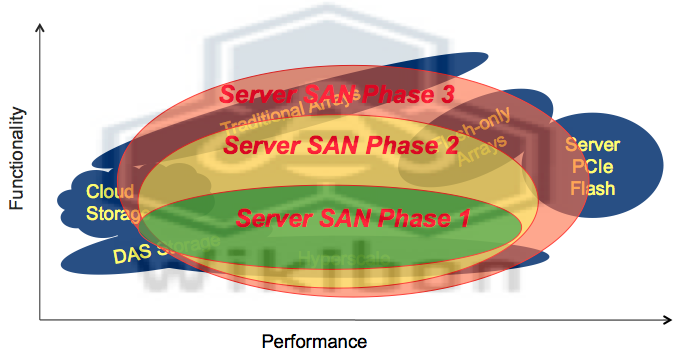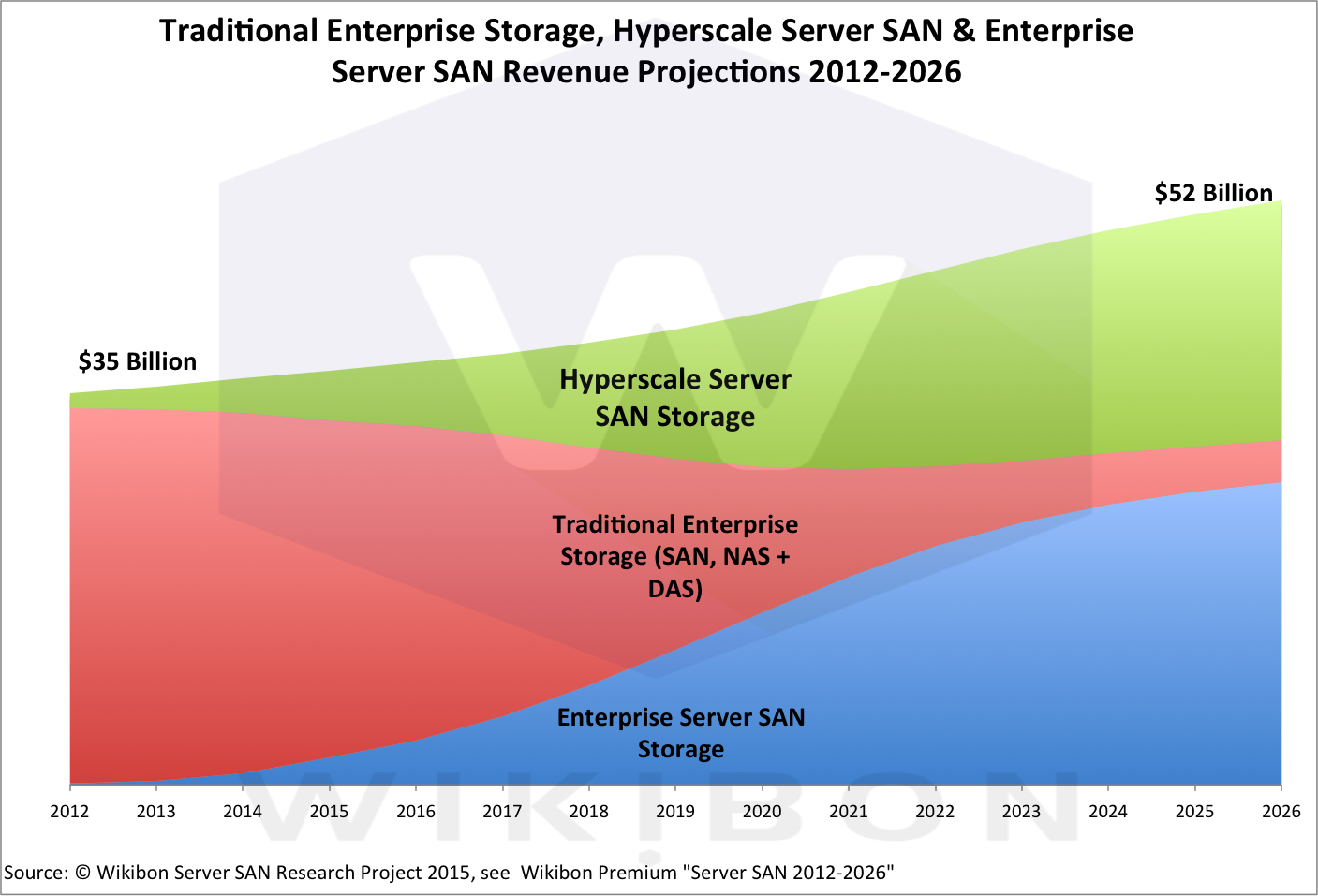Premise
New technologies typically start in niche environments and expand use cases as they mature. Wikibon discussed this dynamic in the initial Server SAN architectures definition in 2014, explaining that hyperconverged infrastructure would move from project-based deployments such as VDI to general usage across the full spectrum of applications seen in enterprise IT. Practitioners that have deployed hyperconverged infrastructure state that hyperconverged infrastructure is a critical component of transforming IT operational models, helping to build what Wikibon calls True Private Cloud.

The Total Experience
When the storage industry first created networked storage (Storage Area Networks, or SANs, block storage; and Network Area Storage, or NAS, file storage), the goal was to allow greater sharing and utilization of storage, rather than having resources dedicated to a specific compute node. Server virtualization helped improve the utilization of compute, but this did not help the utilization of the rest of the stack, and sometimes even hurt storage and networking operations. Converged infrastructure architectures brought together storage arrays and servers into a solution that is faster to deploy than the separate components. This unification was through a combination of packaging, testing and some software integration. While all of these technologies impacted IT roles and equipment utilization, they did not fundamentally change operations.
Hyperconverged infrastructure re-casts the building blocks of the data center into a distributed software-based architecture that eliminates storage as a separate component. It is both the fundamental simplicity and the software architecture that allow for a significant change in the operational model of infrastructure. Thousands of users have deployed hyperconverged infrastructure between Nutanix, VMware VSAN, SimpliVity, and other solutions. The Wikibon research team has spoken to many users to understand the scalability and use cases of these solutions. Wikibon’s Server SAN forecast from 2015 predicts that traditional enterprise storage (SAN+NAS+DAS) will have a -10.1% CAGR over a five year period, while enterprise Server SAN will have a 56.2% CAGR over the same time. As corroborating data, NetApp Flexpod (a solution from NetApp and Cisco often cited as a converged infrastructure reference architecture) had -15% year/year decline for Q4 2015.

Can it scale?
Traditional technology infrastructure companies state that hyperconverged infrastructure solutions are only appropriate for small environments, and do not scale for many enterprise uses. While the solutions on the market vary in scalability and maturity, in general, our research shows that software-based architectures scale. For example, a Nutanix service provider customer told us that they were able to consolidate 10 racks of servers and FC SAN storage down to 12U (a fraction of a rack) of Nutanix gear in the primary data center. The largest single cluster that they currently use is a 40 node configuration for Hadoop. The personnel managing the gear was also reduced from 10 to 1; this was not about eliminating jobs, but allowing IT to spend time on the clients rather than the infrastructure. The user also saw the following results:
- Faster provisioning. Provisioning time for a private cloud with a 3-tier architecture was 1-1.5 weeks, while the hyperconverged solution can be deployed in a couple of hours
- Improved uptime. The service provider kept pricing the same, but adjusted the SLA from 99.99% to 99.9999% with an uptime guarantee included in the maintenance
- Fewer reboots. Older architectures (running Microsoft Hyper-V hypervisor) required a reboot with every hypervisor upgrade, the new architecture (running Nutanix’s Acropolis hypervisor) does not require any reboots.
When asked what he would tell his peers, the SVP of business operations from the service provider customer said, “[We] Early adopters love where we are, and I’m not sure if those that don’t move [to new solutions] will have a job after this year.”
No More Weekend Work
Traditional enterprise IT groups report that the typical activity of “keeping the lights on” is a significant and growing burden. We spoke with one enterprise data center administrator that had to look for simpler infrastructure because his staff was slashed in half, from 12 to 6. They were running an EMC VNX-based, VCE Vblock 300-series cluster between 2 locations, which after 4 years, was still only running at 15-30% utilization. The administrator estimated that periodic upgrades to this system took over 320 hours during the 4 year lifetime — almost all of these upgrades had to be done during weekend time. When the company moved to a new architecture, the hyperconverged infrastructure solution was half the price of the old solution; the smaller building blocks and scale-out architecture will help promote higher infrastructure utilization. Updates for the new solution are a single click, 4 locations took a total of 18 minutes to upgrade. The hyperconverged systems support a broad range of applications including Exchange, database, and VDI. Finally, the new solution saved $4M/year by freeing up enough resources to reclaim SharePoint management from an outsourcer. The user believes that hyperconverged infrastructure adds an ease of management that ties into their strategy to be able to leverage private and public cloud (including AWS and Microsoft Azure).
Shifting IT Towards Innovation
Business users demand that IT be responsive to new requirements. There are some that say that “faster, better, cheaper” can be replaced by “faster, faster, faster”. In another example, we spoke with an enterprise architect at a global chemical company was hired to modernize and simplify IT operations. After moving to the hyperconverged infrastructure he framed, the company was able to eliminate half a petabyte of NetApp filers (saving about $200k per year in maintenance costs) through the use of archiving, deletion, and migration. They no longer needed a dedicated storage engineer; this person was retrained to focus on a simplified backup and recovery solution. Overall infrastructure staffing was reduced from 7.5 to 2.5 FTEs (full time equivalents), and this includes the addition of disaster recovery. IT now has development, QA, and production all on the same cluster, and is seeing a 40% increase in performance across all workloads, which includes SAP. The streamlining of the infrastructure and processes, paired with the flexibility of the new solution, allows IT to be responsive to new demands.
Action Item
Traditional stand-alone SAN storage arrays and NAS filers are seeing a significant decline as newer architectures that leverage flash and advanced software capabilities gain marketshare. The simplicity and economics of hyperconverged infrastructure has reached a point where CIOs should be considering the role that it plays in storage deployments for the next refresh or upgrade.


